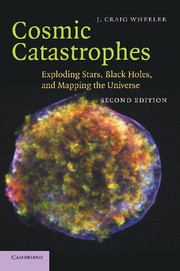Book contents
- Frontmatter
- Contents
- Preface
- 1 Setting the stage: star formation and hydrogen burning in single stars
- 2 Stellar death: the inexorable grip of gravity
- 3 Dancing with stars: binary stellar evolution
- 4 Accretion disks: flat stars
- 5 White dwarfs: quantum dots
- 6 Supernovae: stellar catastrophes
- 7 Supernova 1987A: lessons and enigmas
- 8 Neutron stars: atoms with attitude
- 9 Black holes in theory: into the abyss
- 10 Black holes in fact: exploring the reality
- 11 Gamma-ray bursts, black holes and the Universe: long, long ago and far, far away
- 12 Supernovae and the Universe
- 13 Wormholes and time machines: tunnels in space and time
- 14 Beyond: the frontiers
- Index
6 - Supernovae: stellar catastrophes
Published online by Cambridge University Press: 14 September 2009
- Frontmatter
- Contents
- Preface
- 1 Setting the stage: star formation and hydrogen burning in single stars
- 2 Stellar death: the inexorable grip of gravity
- 3 Dancing with stars: binary stellar evolution
- 4 Accretion disks: flat stars
- 5 White dwarfs: quantum dots
- 6 Supernovae: stellar catastrophes
- 7 Supernova 1987A: lessons and enigmas
- 8 Neutron stars: atoms with attitude
- 9 Black holes in theory: into the abyss
- 10 Black holes in fact: exploring the reality
- 11 Gamma-ray bursts, black holes and the Universe: long, long ago and far, far away
- 12 Supernovae and the Universe
- 13 Wormholes and time machines: tunnels in space and time
- 14 Beyond: the frontiers
- Index
Summary
OBSERVATIONS
Which stars explode? Which collapse? Which outwit the villain gravity and settle down to a quiet old age as a white dwarf? Astrophysicists are beginning to block out answers to these questions. We know that a quiet death eludes some stars. Astronomers observe some stars exploding as supernovae, a sudden brightening by which a single star becomes as bright as an entire galaxy. Estimates of the energy involved in such a process reveal that a major portion of the star, if not the entire star, must be blown to smithereens.
Historical records, particularly the careful data recorded by the Chinese, show that seven or eight supernovae have exploded over the last 2000 years in our portion of the Galaxy. The supernova of 1006 was the brightest ever recorded. One could read by this supernova at night. Astronomers throughout the Middle and Far East observed this event.
The supernova of 1054 is by far the most famous, although this event is clearly not the only so-called “Chinese guest star.” This explosion produced the rapidly expanding shell of gas that modern astronomers identify as the Crab nebula. The supernova of 1054 was apparently recorded first by the Japanese and was also clearly mentioned by the Koreans, although the Chinese have the most careful records. There is a suspicion that Native Americans recorded the event in rock paintings and perhaps on pottery, but other evidence is that the symbols are generic.
- Type
- Chapter
- Information
- Cosmic CatastrophesExploding Stars, Black Holes, and Mapping the Universe, pp. 79 - 117Publisher: Cambridge University PressPrint publication year: 2007
- 1
- Cited by



